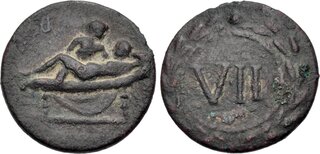| Classical Numismatic Group > Triton XXVII | Auction date: 9 January 2024 |
| Lot number: 665 Price realized: 11,000 USD (Approx. 10,075 EUR) Note: Prices do not include buyer's fees. | Show similar lots on CoinArchives Find similar lots in upcoming auctions on |
| Lot description: Anonymous issues. temp. Tiberius, AD 14-37. Æ Tessera – Spintria (22mm, 3.97 g, 10h). Struck circa AD 22/3-37. Male figure kneeling right on couch, raising left leg of woman laying on her back and resting her head on her left elbow / Campana, Spintriae Series 10, dies D19/VII; Simonetta & Riva scene 10, dies A/VII; Buttrey 8. Brown patina, some roughness and deposits, cleaning scratches, light smoothing. Fine. Extremely rare – only two examples of this die numeral recorded for this particular erotic scene, both of them in museum collections. From the Wayne Scheible Collection. For centuries, numismatists have been puzzled by a curious series of bronze tokens bearing on their reverse numerals from I to XVI. The obverse types on these tokens vary dramatically, bearing not only portraits of Augustus, Tiberius, and Livia, but also various erotic scenes, heterosexual and (possibly) homosexual, or bigas, maenads, capricorns, and other scattered mythological figures. The most prominent theories suggest that they were tickets for entrance to the theater or the games, and the numerals represented sections in the stands, or that they were brothel tokens, with the obverse representing a chosen "product" and the reverse the price. However, both of these theories seem unlikely when one considers that the two seemingly divergent themes are joined by die links to the numeral reverses. Alberto Campana ("Le Spintriae: Tessere Romane con Raffigurazioni Erotiche," in La Donna Romana Imagini e Vita Quotidiana [2009], pp. 43-96) has published a new die study of the erotic pieces, recording eight specimens with at least basic find spot information, most notably a sealed tomb in Modena, firmly dated to the mid-late Julio-Claudian period, as well as other examples found around the Roman world in Palestine, Gaul, Germany, and Britain, often in areas of military interest. He notes that these tesserae are primarily struck in orichalcum, a metal more valuable than regular copper or bronze. Considering the find spots and the metal used in the tokens, Campana suggests that they were luxury gifts given by the Imperial house to important military figures for use in some now-forgotten board game, possibly a variant of duodecim scripta, a game resembling modern backgammon ("Les spintriae et leur possible fonction ludique," in Archeothema 31 [2013], p. 66). Estimate: 3000 USD |  |



